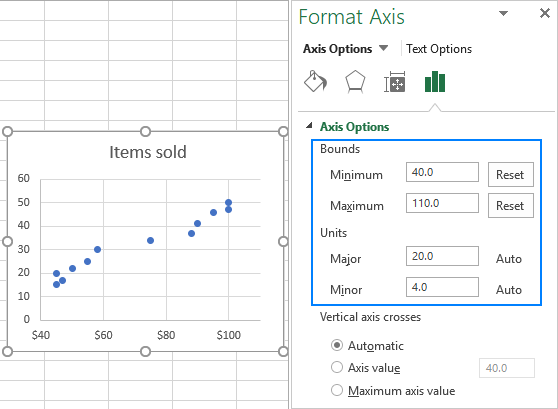
- #Changing axis size excel mac os pdf
- #Changing axis size excel mac os code
- #Changing axis size excel mac os trial
Because they are vector images, PDFs tend to have the best resolution, but to get a standalone image you still need to export it from Adobe as an image file.

#Changing axis size excel mac os pdf
Save the graph (made in either Excel or PowerPoint) as a PDF file (through the SaveAs or Print menus), crop in Adobe, and then save as an image. I’ve tested that approach and the quality of the final images is still not that high, likely because the image resolution still depends on the resolution of the screen.
#Changing axis size excel mac os code
It is possible to build an image exporting engine in Excel ( like this one from Jon Peltier) using VBA code (on PCs only). (Only the first method works on Macs though). I find that this second method creates more higher-quality images. Second, right-click on the graph and SaveAs a Picture. On PCs, there are two ways to get the slide/image out of PowerPoint: First, use the standard SaveAs command. If the user wants the Excel graph to be a specific size, then the PPT slide could be set at those dimensions. Copy the graph from Excel, paste into PowerPoint, and export. I did not test third-party tools like Camtasia or Screencast-o-matic in this exercise, but consistent image sizes will be an issue whenever you need to manually select the area of the screen to capture. The other big problem with screenshots is that image size may vary depending on exactly where the user places their cursor.

Mac screenshots are going to be better than those taken on PCs because of the inherent better resolution of Mac screens. I can summarize these methods into five main categories: I think there is a better way to obtain high-quality images out of Excel and have tested a number of different ways to do so. Future Directions for the Demography of Aging Source: Example of a blurry set of images. The screenshot solution doesn’t always work because the quality of the screenshot depends on the resolution of the monitor. Many people create standalone graphs by taking screenshots of their Excel window, but screenshots can look blurry and pixelated, especially next to text that surrounds it.

22% as for a test workbook.As you probably know, Excel does not have a native image-exporting feature, so it requires a separate process to create a high resolution, standalone Excel chart. This method could reduce the file size – depending on your images – by app. Monitor the impact on the file size by saving the workbook after each compression. Maybe you try the highest resolution first and go down step by step. Excel can also delete the cropped areas of pictures if you’ve used the cropping tool.
#Changing axis size excel mac os trial
But our Excel add-in helps (7-day free trial without sign-up): Just press the “Reduce File Size” button and then click on “Check size of each worksheet”.

How do you get to know the file size of each worksheet? There is no simple built-in way in Excel. Then you just start with the largest worksheet and depending on the type, you just do the specific methods. We recommend you to check the file size of each worksheet. Or – and that’s the recommended way – you do it more systematically. So how do you find out, which type(s) might be the case for you?Įither, you just go ahead and try the following methods. Others: Meta-data, other invisible contents.įor each of these types, the approach of reducing the file size is different.Formatting: If sheets are formatted although cell ranges aren’t used, the file size might increase.Pivot Tables: Pivot Tables store the underlying data so (depending on the number of Pivot Tables) in worst case, each Pivot Table contains the data set.Pictures: Do you have any images in your file?.Large data, usually worksheets with more than 100,000 rows and/or many columns.The important question: What part of your Excel workbook causes the large file size. Get to know the file size of each worksheet, e.g.


 0 kommentar(er)
0 kommentar(er)
